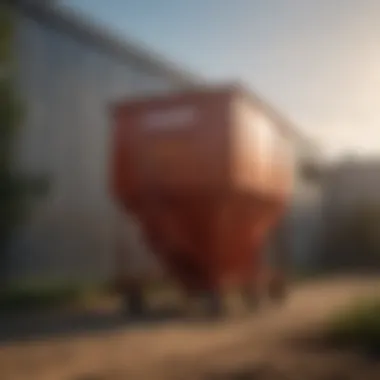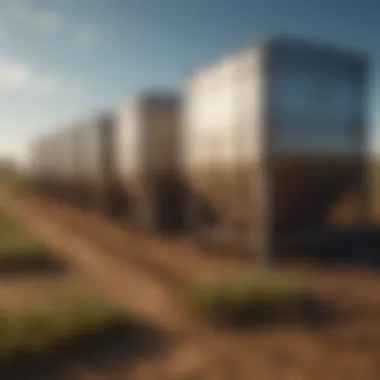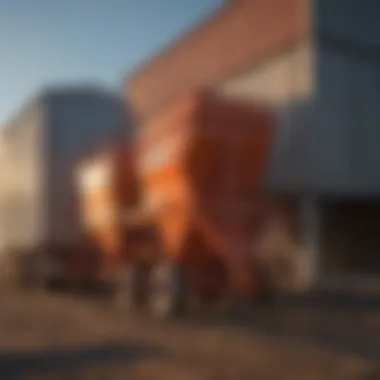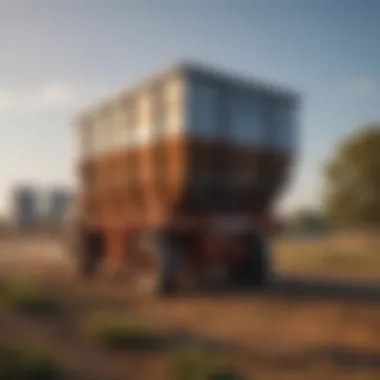Exploring Metal Hopper Bins: Benefits and Applications


Intro
The metal hopper bin plays a vital role in agriculture. It serves as a storage unit designed for various materials, especially grains. Understanding the functionality and advantages of these bins can greatly impact operational efficiency on farms. Farmers and agricultural professionals benefit from deeper insights into design aspects and applicability.
A focus is needed on basic definitions and historical context surrounding metal hopper bins. Recent innovations in design and usage also merit attention, particularly how they align with sustainability goals. Practical applications demonstrate the utility of these bins in real-world settings. This article will explore these dimensions in detail.
Prolusion to Metal Hopper Bins
Metal hopper bins play a vital role in agricultural operations, serving as efficient storage solutions for various materials. Their design allows for optimal storage and effortless transport of items such as grains, fertilizers, and seeds. Metal construction imparts durability, making them preferred choices for farmers who require robust storage solutions. This section will delve deeper into the definition and purpose of these bins, as well as provide a historical context to understand their evolution and significance in modern agriculture.
Definition and Purpose
A metal hopper bin is a container that typically features a wide top, narrow bottom, and a sloped base. This design facilitates the easy flow of materials out of the bin. The purpose of these bins extends beyond mere storage; they are essential for maintaining the quality of stored products by protecting them from environmental factors such as moisture and pests. In addition, their structural integrity allows for quick access to materials, significantly improving operational efficiency for farmers and agribusinesses alike.
Historical Context
The history of metal hopper bins can be traced back to early agricultural practices. Initially, farmers relied on wood or stone containers that often lacked durability. As agricultural mechanization progressed, metal became the material of choice due to its strength and longevity. Over the decades, advancements in metalworking techniques and technology have led to the development of more sophisticated designs, enhancing their functionality and appeal. Today, metal hopper bins are standard in many agricultural settings, with innovations in size, capacity, and design catering to the specific needs of the farming community. The historical evolution demonstrates a shift from basic storage solutions to highly engineered systems that support modern agricultural demands.
Design Features of Metal Hopper Bins
Understanding the design features of metal hopper bins is paramount in appreciating their role in agriculture. These features contribute not only to the functionality of the bins but also to their effectiveness in various applications. This section details critical aspects such as material composition, structural integrity, and various capacity and size variations, which influence how these bins perform in real-world scenarios.
Material Composition
The material used in constructing metal hopper bins plays a critical role in determining their durability and performance. Generally, metal hopper bins are made from either galvanized steel or stainless steel. Galvanized steel is popular due to its corrosion resistance and lower cost. However, stainless steel offers superior strength and longevity, often justifying its higher price. The added advantage of stainless steel is its resistance to rust and degradation, which is beneficial in wetter conditions.
When considering material composition, it’s vital to assess the environment in which the bins will be used. Bins exposed to harsh chemicals or extreme weather conditions may require specific materials to ensure optimal performance. The choice of material also impacts ease of maintenance, an essential consideration for farmers striving to minimize downtime.
Structural Integrity
Structural integrity is another key consideration in the design of metal hopper bins. This aspect ensures that the bins can withstand the weight of the materials stored within, as well as external forces such as weather conditions. High-quality fabrication processes enhance structural integrity, allowing bins to maintain their shape and function over time.
Key factors influencing structural integrity include the thickness of the metal and the design of the seams and joints. Thicker metal contributes to strength, while proper joint design prevents failure points. Regular maintenance checks are necessary to catch any signs of wear or weakness that could compromise functionality. A bin with compromised structural integrity can not only fail in its intended purpose but can also pose safety risks.
"A well-designed metal hopper bin ensures durability and efficiency, while also safeguarding against operational failures."
Capacity and Size Variations
Capacity and size variations in metal hopper bins provide flexibility to cater to diverse operational needs. These bins come in various sizes, from small units suitable for personal farms to large-scale versions for commercial operations. Understanding the right size for specific applications is essential for optimizing efficiency.
Smaller bins may be ideal for farmers with limited space or those handling smaller quantities of materials, while larger bins are suited for bulk storage needs. The capacity also affects transportation efficiency; larger bins often maximize space during transport, reducing costs.
When selecting a bin, consider not just the current storage needs, but also future requirements. This foresight can prevent unnecessary investments in additional units, ultimately contributing to a more streamlined operation.
Functional Aspects
Understanding the functional aspects of metal hopper bins is key for anyone involved in agriculture. These bins serve several essential roles, significantly influencing both storage and transportation processes. By analyzing these functionalities, one can appreciate how metal hopper bins enhance operational efficiency and safeguard agricultural products.
Storage Capabilities
Metal hopper bins are designed primarily for storage. They can hold a variety of materials, such as grains, fertilizers, and seeds. Their robust structure supports bulk storage without compromising the integrity of the materials. One important feature is the airtight seal that many models provide. This prevents moisture ingress, helping to preserve quality.
Additionally, metal construction offers protection against pests and rodents. This is crucial, especially in rural or agricultural settings. With various sizes available, these bins can meet the specific needs of different operations. Some common capacities range from small units for personal use to large industrial containers.
"Metal hopper bins enhance storage flexibility and safety in agricultural operations."
The ease of access is another noteworthy aspect. Most designs incorporate a straightforward opening mechanism. This allows for easy filling and dispensing of materials. Some bins come with built-in flow control systems, allowing for precise distribution. This is especially beneficial when managing feed rations or fertilizer applications.


Transportation Efficiency
The role of metal hopper bins in transportation cannot be understated. Their design allows for efficient movement of goods from one point to another. Many models are compatible with various transport equipment, such as trucks and forklifts. This compatibility optimizes loading and unloading times, thereby reducing overall operational costs.
Moreover, due to their durable structure, metal hopper bins can endure harsh handling during transport. This resilience minimizes the risk of damage to the stored materials. Thus, they provide peace of mind for those transporting valuable agricultural products.
In addition, some bins are designed with mobile capabilities. Certain models include wheels or trailers, making it easier to move materials directly to the field or destination. This flexibility enhances logistics, particularly for farmers managing multiple fields or sites.
In summary, the functional aspects of metal hopper bins profoundly impact both storage and transportation in agriculture. Their ability to protect and efficiently manage resources is critical for modern farming operations.
Benefits of Using Metal Hopper Bins
Metal hopper bins provide many advantages that enhance their performance in agricultural operations. Understanding these benefits can guide farmers and businesses in optimizing their storage and transportation strategies. Below are the key benefits of using metal hopper bins, focusing on longevity, durability, environmental protection, and cost-effectiveness.
Longevity and Durability
The longevity and durability of metal hopper bins stand out as significant advantages. Constructed from robust materials, these bins can endure harsh conditions. Unlike plastic bins, which can deteriorate over time due to UV exposure or extreme temperatures, metal bins retain structural integrity. Many steel variants undergo galvanization, further enhancing resistance to corrosion.
Regular maintenance can extend these bins' lifespan even more. Inspections should focus on weld integrity and surface condition. By identifying wear and tear early, operators can prevent more extensive damage. The robust construction becomes a long-term investment for farmers needing reliable storage solutions.
Protection from Environmental Elements
Another important benefit is the level of protection metal hopper bins offer against environmental factors. They safeguard contents from moisture, pests, and extreme weather conditions. By minimizing the risk of contamination, metal bins help maintain the quality of stored products like grains and fertilizers.
In addition, the heavy-duty design is less susceptible to damage during storms or other adverse conditions. This level of protection translates into fewer product losses and reduced chances of spoilage. Thus, utilizing metal hopper bins effectively contributes to overall operational efficiency.
Cost-Effectiveness
Investing in metal hopper bins can also be a cost-effective decision for agricultural operations. While the upfront costs might be higher than plastic alternatives, the long-term savings often outweigh initial expenditures. The durability and longevity of metal bins lead to reduced replacement frequency, which translates into lower long-term costs.
Additionally, since they require less frequent maintenance and have a longer replacement cycle, they provide better value over time. Farmers can allocate saved resources elsewhere in their operations.
"Metal hopper bins may have a higher initial cost, but their durability leads to lower replacement rates and maintenance expenses, making them a smart investment in the long run."
Understanding these benefits allows for better decision-making when choosing storage solutions in agriculture, ultimately impacting productivity and profitability.
Applications in Agriculture
The use of metal hopper bins in agriculture cannot be overstated. They play a vital role in the storage and transportation of various agricultural products. This section explores specific uses, advantages, and important considerations of metal hopper bins in agricultural practices.
Grain Storage
Metal hopper bins are primarily known for their application in grain storage. They provide an effective solution for storing large quantities of grain safely. Here are important aspects of their use in grain storage:
- Volume Efficiency: Metal bins can hold significant amounts of grain due to their vertical design. This maximizes storage space on farms, crucial for farmers who deal with large harvests.
- Pest Control: Metal construction is less prone to pest invasions compared to wood or plastic. This benefit helps in maintaining grain quality and minimizing losses.
- Moisture Regulation: Many metal hopper bins come with features that reduce moisture build-up inside, helping to preserve the quality of stored grain.
Overall, the reliability of metal hopper bins ensures that grain remains in optimal condition, contributing to better harvest outcomes and profitability.
Fertilizer Distribution
The efficiency of metal hopper bins extends beyond storage to include fertilizer distribution. They offer several key advantages:
- Durability: The strong material composition ensures that fertilizer is stored securely without the risk of contamination or spillage. This matters greatly for nutrient-rich materials that need to stay intact.
- Ease of Handling: Many metal hopper bins are designed for easy loading and unloading, improving workflow and reducing labor costs for farmers.
- Customizable Options: Bins can be adapted for specific types of fertilizers, catering to the diverse needs of different crops. Farmers can benefit from tailored solutions that enhance efficiency.
In essence, the application of metal hopper bins for fertilizer distribution supports effective farming practices, enabling precision in nutrient management and supporting crop health.
Feed and Seed Usage


Metal hopper bins are also essential in storing feed and seeds. This application carries several important benefits:
- Safety and Security: The robust nature of metal protects feed and seed from environmental factors, pests, and rodents. This ensures that farmers maintain consistent quality.
- Long-Term Storage: Their structural integrity allows for both short and long-term storage. This flexibility is valuable for farmers who need to store products for various seasons.
- Accessibility Features: Many bins have accessible designs that facilitate easy access for farmers, saving valuable time during busy seasons.
The use of metal hopper bins for feed and seed storage is a practical choice, aiding farmers in their operations and ensuring that they can meet the demands of livestock and crop cultivation effectively.
Maintenance and Care
Effective maintenance and care of metal hopper bins is essential for optimizing their performance and ensuring longevity. Regular upkeep not only protects the investment in these bins but also enhances operational efficiency. Careful maintenance minimizes the risk of unexpected issues that can disrupt agricultural operations, ensuring that storage and transport remains seamless.
Regular Inspections
Routine inspections are a cornerstone of maintenance practices for metal hopper bins. This task should include checking for visible signs of wear and tear, such as rust or structural weaknesses. Consistent monitoring allows for early detection of potential problems, which can then be addressed before they escalate into costly repairs. Inspecting the liner, if present, is equally crucial, as it protects the metal from corrosion caused by materials inside the bin. Regular assessments can also help ensure that the bin's seals and fittings are in good condition, preventing leaks and other issues.
Cleaning Protocols
Keeping metal hopper bins clean directly impacts their efficiency and reliability. Develop a cleaning schedule that aligns with the types of materials used for storage. For example, bins used for grains should be cleaned more frequently than those used for non-perishable supplies. Use non-corrosive cleaning agents and equipment that won’t scratch the bin's surfaces. It is essential to remove residue and contaminants to avoid spoilage or contamination of future loads. The cleaning process should also include checking for any build-up in the auger or other moving parts, as this can hinder functionality and cause malfunctions.
Repair Considerations
When inspecting and maintaining metal hopper bins, repair considerations should always be on the forefront. Should damage occur, it is important to assess whether it is a simple fix or requires professional intervention. Minor rust spots can often be treated with a rust-inhibiting primer and paint, while more significant structural issues may necessitate expert repair or replacement. Timely repairs are essential to prevent further deterioration that can compromise not only the bin itself but also the materials being stored. Keep in mind the manufacturer's recommendations for repairs and parts replacement to ensure compliance with safety and operational standards.
Regular inspections and cleaning not only prolong the life of your metal hopper bin but also enhance the safety and quality of stored materials.
Regulatory Standards and Compliance
Regulatory standards and compliance play a vital role in the functionality and safety of metal hopper bins. These standards ensure that products meet specific criteria set forth by government agencies and industry organizations. They also establish guidelines for manufacturers and users, focusing on the safety and environmental impact of metal hopper bins in agricultural applications. By adhering to these regulations, stakeholders can minimize risks, enhance operational efficiencies, and protect the health of both workers and consumers.
Health and Safety Regulations
Health and safety regulations are essential to protect those handling metal hopper bins. Such regulations often dictate the construction and design of these bins. For instance, standards may specify the use of certain materials that resist corrosion, ensuring the safety of stored products. Additionally, guidelines related to weight limits and securement help prevent accidents during transport and use.
"Adhering to health and safety regulations can substantially reduce incidents caused by equipment failure or misuse."
Farmers and equipment operators should be familiar with local and national regulations. Compliance can lead to safer working environments, reduce liability, and build trust within the community.
Regular training for personnel on safety measures is also critical. This includes properly filling and emptying bins, using appropriate equipment, and ensuring a clean working environment. Maintaining comprehensive records of safety inspections and adherence to regulations demonstrates diligence and commitment to safety.
Environmental Considerations
Environmental considerations related to metal hopper bins focus on minimizing ecological impact. The manufacturing process of these bins must comply with environmental regulations that aim to limit pollution and promote sustainability. This includes using materials that are recyclable and reducing waste during production.
Moreover, the design of metal hopper bins should account for environmental factors. For example, bins that prevent spillage during loading and unloading can protect soil and water from contamination. Another important aspect is the treatment of materials stored within the bins. Ensuring that non-toxic materials are used not only complies with environmental standards but also contributes to healthier agricultural practices.
Comparative Analysis
Conducting a comparative analysis within the context of metal hopper bins serves as a crucial step for understanding the nuanced differences that affect agricultural operations. It highlights key elements such as material composition, design options, and operational efficiency. Farmers and industry professionals need to make informed decisions tailored to their specific needs.
Metal vs. Plastic Hopper Bins
Metal and plastic hopper bins each have distinctive characteristics that impact their functionality and usability in agricultural settings. Metal hopper bins generally offer superior durability and longevity. They are less susceptible to damage from external pressures, making them an excellent option for harsh environmental conditions. This durability is especially beneficial in situations requiring significant movement of materials, like grain storage.
On the other hand, plastic hopper bins can be lightweight and more affordable, which appeals to those with lower budget constraints. They also have better resistance to corrosion and can be less affected by moisture or chemicals. However, they might lack the structural integrity required for heavy-duty applications.
When considering which bin to use, factors such as lifespan, cost, and application should be prioritized. Durability of metal bins often justifies their higher initial cost when one accounts for their functionality over time. Plastic bins, though cheaper, may need more frequent replacements, thus raising long-term costs.
Ultimately, the decision between metal and plastic hinges on specific operational requirements, available budget, and the environmental conditions faced by the bin.


Static vs. Mobile Systems
The choice between static and mobile hopper bin systems often defines the efficiency of material handling practices. Static systems are fixed in one location, best suited for long-term storage of bulk materials like grain. They are designed for maximum capacity and durability, facilitating the storage of large volumes in a single spot.
In contrast, mobile systems offer flexibility and versatility. They can be moved from one location to another, proving beneficial for farmers who need to transport materials across various field sites. However, they might come with limitations concerning capacity and stability compared to static systems.
When deciding on the type of system to implement, it is important to consider the following:
- Operational needs: Think about the frequency of movement needed within the agricultural practice.
- Site conditions: Take into account the terrain and layout of the farming area.
- Material type: The nature of the material being stored can influence the system choice.
Knowing the advantages and disadvantages of both systems aids in minimizing risks and optimizing efficiency.
A well-considered choice between metal or plastic and static or mobile systems can drastically affect operational success.
Future Trends in Metal Hopper Bin Technology
The advancement of technology is driving significant changes in the agricultural sector, and metal hopper bins are no exception. As the demands for efficiency and sustainability grow, these bins are evolving to incorporate innovative features. This section explores two main trends: the innovation in materials used and the integration of smart technology. These developments not only enhance the functionality of metal hopper bins but also provide economic and environmental benefits.
Innovation in Materials
The materials used in metal hopper bins are crucial for their performance and durability. Traditional metals, while sturdy, can become heavy and may not offer the best resistance to corrosion. Recent advancements are leading to the use of high-strength, lightweight alloys, which can significantly improve the lifecycle of the bins.
- Benefits of Innovative Materials:
- Examples of Innovative Materials:
- Weight Reduction: Lighter materials enhance the ease of transport and installation, making operations smoother.
- Corrosion Resistance: Newer alloys resist environmental damage, prolonging the lifespan of the bins.
- Thermal Properties: Improved materials can manage temperature better, protecting sensitive contents.
- Aluminum alloys designed for farming equipment.
- Coatings that resist chemical exposure, ensuring safety for various agricultural products.
These innovations not only lead to improved operational efficiency but also reduce maintenance needs, ultimately saving costs for farmers.
Integration with Smart Technology
As the industry leans towards precision agriculture, the integration of smart technology in metal hopper bins is becoming vital. This trend emphasizes efficiency and real-time monitoring of bin conditions.
- Features of Smart Technology:
- Advantages of Smart Technology:
- Sensors: Embedded sensors can provide data on the bin’s contents and environmental conditions. These sensors enable farmers to manage their inventory effectively.
- IoT Connectivity: Bins equipped with internet capabilities allow for remote monitoring and management. This means timely adjustments can be done without requiring on-site inspections.
- Informed Decision-Making: Access to real-time data enables farmers to make better decisions regarding storage and transportation.
- Resource Management: Smart bins can assist in optimizing resource usage, reducing waste and maximizing efficiency.
The incorporation of smart technology in metal hopper bins revolutionizes how agricultural storage is conducted, positioning farmers for future challenges.
Future trends in metal hopper bin technology are more than a response to current needs; they reflect a commitment to sustainability and operational excellence. When farmers embrace these advancements, they are not just investing in storage solutions, but in a more efficient and profitable agricultural future.
Epilogue
The conclusion is a critical part of this article, summarizing the importance of metal hopper bins in agriculture. They serve as essential tools for the storage and transportation of various agricultural products. Understanding their functionality and benefits allows farmers to make informed decisions when selecting these bins for their operations.
Summary of Key Points
Metal hopper bins provide several advantages, including:
- Durability: Made from robust materials, they withstand harsh weather conditions.
- Efficiency in storage: Their design allows for easy stacking, maximizing storage space.
- Versatility: Suitable for different materials like grain, fertilizer, and seeds.
These aspects make them indispensable in modern agriculture, helping improve productivity and ensure quality preservation of the stored products.
Implications for the Future
The future of metal hopper bins looks promising, with ongoing innovations in materials and technology. As environmental concerns rise, manufacturers are likely to implement more sustainable options. Furthermore, the integration of smart technology will revolutionize how these bins are used, allowing for real-time monitoring of contents and conditions.
This evolution means that metal hopper bins will not only continue to be relevant but may also enhance operational strategies significantly. Adapting to these trends will be crucial for farmers looking to optimize their handling of agricultural materials.
"Innovations in the agricultural sector are pivotal to meeting future demands."















